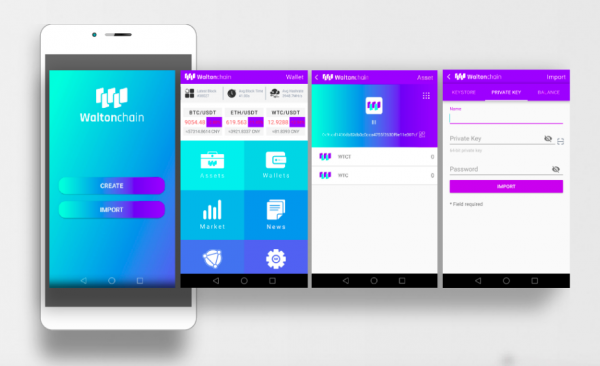Waltonchain integrates blockchain, big data, and low cost RFID chip technology, to create what they call the Value Internet of Things (VIoT).
According to the Waltonchain whitepaper, the VIoT is:
A perfect commercial ecosystem which integrates the real world and the blockchain.
Waltonchain’s goal is to build a world-wide network of “smart objects”, that are connected to the internet. These objects will have embedded sensors that gather data about their external environment. The sensors can track location, time, temperature, humidity, etc.
The smart objects will produce mountains of data for manufacturers. This will allow for complete supply chain tracking, authentication of products, and traceability of sources for manufactured goods.
The data generated by smart objects will improve the safety, transparency, and value of manufactured products within a supply chain.
Waltonchain is a giant leap towards a refined commercial ecosystem driven by data. This data will provide increased knowledge about a product, its suppliers, and consumers who use them.
By using data, manufacturers will be able to create products based on what a customer wants, not based on what they think a customer wants.
Waltonchain is moving fast toward implementation with large enterprises in both China and around the world. They already have an impressive list of partnerships which includes: Alibaba, Accenture, China Mobile IoT Alliance, China Telecom, Korean IoT Research Center, Mobius, Morpheus Network, Skynovo, with more coming soon.
What Happened in Waltonchain’s Q2
WTC has had an eventful Q2, and has added new strategic partnerships. These partnerships include Kaltendin and Skynovo. This year, they are moving towards the implementation of their IoT systems, starting out with high-end men’s fashion, food products, and retail. They have also begun working towards an intelligent food and beverage management system for the catering industry, with a company called Ishijah Trading.
Waltonchain has made a lot of progress with their low cost RFID tech. The cost of these sensors has been reduced to just $0.05 per chip!
They have applied for over 20 patents and are continuing their sensor research by creating the Smart City Blockchain Sensor Laboratory in Korea.
In April, WTC released a new Android wallet, and they’re soon going to release an iOS wallet. The iOS wallet was submitted to the app store in Q2. (It is currently seeking approval to be released to the public.)

Also in April, Waltonchain began its preparation to expand to new territories worldwide. These new markets include: South America, Japan, and Russia.
WTC recently began their Proof-of-Work mining reward program in May, 2018. It supports both CPU and GPU mining on PCs.
The Waltonchain wallet allows you to start mining directly on a CPU. It is available for download from Waltonchain.org. (Currently, mining on Mac computers is unavailable.)
Waltonchain also released its first child chain called FreyrCoin (FREC), in May of Q2.
FREC recently conducted a successful airdrop, where each participant received 288 Freyrcoins.
What’s To Come in Q3
Coming up this quarter, Waltonchain is looking to implement its system in the sector of “smart retail.” They plan to launch their first unmanned clothing smartstore in September of 2018.
The two pilot programs with Kaltendin (for clothing) and Skynovo (for food production) were released in Q2.
6 “child chains” have already been created for the Walton platform. Each child chain will have unique features, which are specialized for each sector of business.
Eventually, millions of child chain transactions could be processed on the Walton blockchain!
These child chains will have features applicable to different sectors of business which include: agriculture, retail, energy, and clothing.
Cross-child-chain transmission will create a large demand for Walton, as well as an increase in its value. All transactions will require the expenditure of WTC. This will lead to higher demand of WTC tokens.
More child chains will be coming in Q3, including the release of a clothing child chain called Fashion Chain.
Q3 will bring a planned expansion of the RFID system, as well as the completion of the RFID tag supply chain system. WTC will complete the R&D on its cutting-edge read/write hardware in September 2018.
Waltonchain’s Near Future
As we move into Q4 and beyond, WTC will continue towards its goal of constructing a commercial ecosystem driven by data.
Waltonchain will launch its tech in industries like fashion, food, and retail.
After that, they will expand into smart cities, smart grids, supply chains, smart retail, energy, and agriculture.
WTC offers infinite use cases for both public or private blockchains. Its overall goal is to improve the efficiency of ANY market, using sensor data generated by smart objects.
The sensor data will create new insights into customer behavior, and will give manufacturers the ability to create products based on this data.
Data will allow companies to discover exactly what their customers want. It will allow manufacturers to create products that target a specific consumers’ needs. The data will increase sales, credibility, and brand value.
Another use case for Waltonchain, is in retail.
WTC is now building a platform for “smart retail”. They already have a working demo of a smart shelf. The smart shelf provides data about clothing items, and tracks items when they are removed from the rack.
This data includes price, history, and other relevant information. The smart-shelf allows automatic checkouts for multiple items, and can trigger anti-theft alarms if the clothing is removed from the store.
The Waltonchain Medium blog states that aspects of retail, including “production, design, logistics, storage, centralized procurement, physical sales, service activities, operation management and capital flow will be integrated into the digital and smart platforms.”
WTC will also allow for authenticity tracking.
Authenticity tracking should end, or severely reduce, the counterfeiting of products, using the sensor’s tracking data. Businesses will be able to recover the income that they’ve lost to fake products.
The Walton system will create accountability for all of the parties involved in the production of each item. If there is a problem, it can easily be spotted and fixed, using this data.
Conclusion
Waltonchain is breakthrough technology for IoT, with many use cases for its platform.
Out of its three main competitors, which include Vechain, Origin Trail, and Ambrosus, Waltonchain is the furthest towards their goal. All of the competitors have great projects and teams. But, at this point, no company can match Walton’s partnerships, sensor tech, or implementation.
Building the IoT is an enormous undertaking, and Waltonchain has an amazing team which is up for the task.
Their ecosystem of sensors and data will soon span the entire world. They will increase the efficiency of manufacturing, as well as provide accountability to all producers involved in the supply chain of each product.

